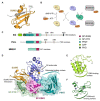Plant SUMO E3 Ligases: Function, Structural Organization, and Connection With DNA
- PMID: 33897743
- PMCID: PMC8064691
- DOI: 10.3389/fpls.2021.652170
Plant SUMO E3 Ligases: Function, Structural Organization, and Connection With DNA
Abstract
Protein modification by the small ubiquitin-like modifier (SUMO) plays an important role in multiple plant processes, including growth, development, and the response to abiotic stresses. Mechanistically, SUMOylation is a sequential multi-enzymatic process where SUMO E3 ligases accelerate SUMO conjugation while also influencing target identity and interactions. This review explores the biological functions of plant SUMO E3 ligases [SAP AND MIZ1 DOMAIN-CONTAINING LIGASE (SIZs), METHYL METHANESULFONATE-SENSITIVITY PROTEIN 21 (MMS21s), and PROTEIN INHIBITOR OF ACTIVATED STAT-LIKE (PIALs)] in relation to their molecular activities and domains. We also explore the sub-cellular localization of SUMO E3 ligases and review evidence suggesting a connection between certain SUMO E3 ligases and DNA that contributes to gene expression regulation.
Keywords: DNA-binding proteins; SUMO E3 ligases; SUMOylation; abiotic stress; structure-function analysis.
Copyright © 2021 Jmii and Cappadocia.
Conflict of interest statement
The authors declare that the research was conducted in the absence of any commercial or financial relationships that could be construed as a potential conflict of interest.
Figures

References
-
- Brown J. R., Conn K. L., Wasson P., Charman M., Tong L., Grant K., et al. . (2016). SUMO ligase protein inhibitor of activated STAT1 (PIAS1) is a constituent promyelocytic leukemia nuclear body protein that contributes to the intrinsic antiviral immune response to herpes simplex virus 1. J. Virol. 90, 5939–5952. 10.1128/JVI.00426-16, PMID: - DOI - PMC - PubMed
Publication types
LinkOut - more resources
Full Text Sources
Other Literature Sources
Research Materials
Miscellaneous

